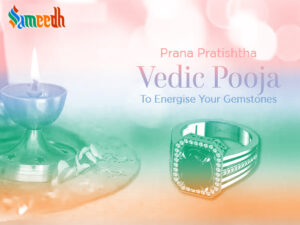Pran Pratishtha is a ritual in Hinduism that involves invoking the divine energy or spirit into an idol, deity, or sacred object. The term “Pran Pratishtha” can be translated to mean “infusing life” or “establishing the life force.” This ritual is often performed during the consecration of idols in temples or during the initiation of specific spiritual objects, such as gemstones in the context of Vedic astrology.

The terms “Prana,” meaning “life force/breath/spirit,” and “Pratishtha,” meaning “installed,” refer to the rite of infusing the spirit of god in the vessel or gemstone. Prana Pratishtha is a stronger form of Vedic puja where hymns and mantras are chanted in the name of the individual. According to Indian astrology, the ceremony hymns are chanted to invite the deities and have them reside in the astrological gemstones, which are nothing more than a particle of the natal planets.
Prana Pratishtha is typically performed by learned priests who have a thorough understanding of all four Vedas. The prana pratishtha puja is practiced through 16 traditional rituals to invite the blessings of the deities of the ruling planets, starting with inviting the deity with love and respect to invite their blessings and sending them back to their abode.
Here are general steps involved in the Pran Pratishtha ritual:
- Purification of the Object:
- The object, whether it’s an idol, deity, or gemstone, is thoroughly cleaned and purified. This may involve washing it with water, milk, yogurt, honey, ghee, or other sacred substances.
- Selection of an Auspicious Time:
- The ritual is performed at an auspicious time, taking into consideration the individual’s birth chart, planetary positions, and specific astrological considerations.
- Creating a Sacred Space:
- A clean and consecrated space is set up for the ritual. This may involve drawing specific patterns (yantras) or diagrams, lighting incense, and arranging offerings.
- Invoking Deity or Divine Presence:
- Mantras are recited to invoke the presence of the deity or the divine energy associated with the object. These mantras may be specific to the deity or may be general invocations seeking divine blessings.
- Transferring Life Force:
- The ritual leader, often a priest or a person knowledgeable in the ceremony, then performs specific gestures and recites mantras to transfer the life force (Prana) into the object. This is believed to bring the divine presence into the object, making it sacred and spiritually potent.
- Offerings and Blessings:
- Offerings such as flowers, fruits, incense, and other items may be presented to the consecrated object as a symbol of devotion. Blessings are sought for the well-being, prosperity, and protection associated with the consecrated item.
- Sealing the Ritual:
- The ritual is concluded with additional prayers, mantras, and the sealing of the divine presence within the object. This may involve the sprinkling of holy water or the marking of specific symbols.
Gemstones are vessels that retain a higher level of energy and potency. Performing a prana pratishtha strengthens the magnetic field of gemstones, transforming them into Yantras with their own healing powers. These yantras ultimately help the wearers magnify their mediated states of mind and align their vibrations. A gemstone that hasn’t been energized or charged is purely ornamental.
It’s important to note that the specific details of the Pran Pratishtha ritual can vary based on the tradition, deity, or purpose for which it is performed. Additionally, individuals seeking to perform this ritual for gemstones or other objects may consult with a knowledgeable priest or spiritual guide for guidance on the specific procedures and mantras suitable for their practice.